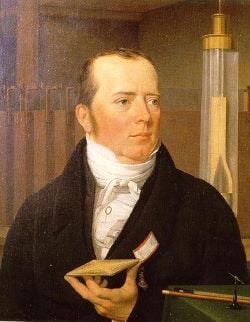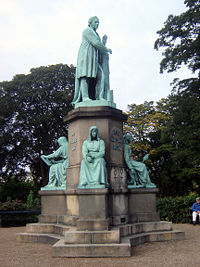Encyclopedia, Difference between revisions of "Hans Christian Ørsted" - New World
Peter Duveen (talk | contribs) |
|||
| Line 49: | Line 49: | ||
== References == | == References == | ||
<<This article needs at least 3 reliable references, properly formatted.>> | <<This article needs at least 3 reliable references, properly formatted.>> | ||
| + | Lives of the Illustrious (The Biographical Magazine), J Passmore Edwards London 1852 V II, 297-310 | ||
| + | |||
| + | The Soul In Nature, by Hans Christian Oersted, tr. L. and J.B. Horner, 1852 Henry G. Bohn. London (From the biographical sketch by P.L. Moller) vii-xxii | ||
== External links == | == External links == | ||
Revision as of 09:36, 27 April 2007
| Hans Christian Ørsted |
|---|
| Born |
| August 14, 1777 Rudkøbing, Denmark |
| Died |
| March 9, 1851 Copenhagen, Denmark |
Hans Christian Ørsted (spelled Oersted when the Danish letter Ø is unavailable) (August 14,1777 – March 9, 1851) was a Danish physicist and chemist, influenced by the thinking of Immanuel Kant. He is best known for discovering the relationship between electricity and magnetism known as electromagnetism.
Early life and studies
Ørsted developed his interest in science while working as a young boy for his father, Søren Christian Ørsted, who owned a pharmacy. He and his brother, Anders Sandøe Ørsted, received most of their early education through self-study at home, and went to Copenhagen in 1793 to take entrance exams for Copenhagen University. The brothers passed and distinguished themselves academically at the University. By 1796, Hans Christian Ørsted received honours for his papers in both aesthetics and physics.
In 1801, he received a travel scholarship and public grant that enabled him to spend three years traveling in Europe. In Germany, he met Johann Ritter, a physicist who believed there was a connection between electricity and magnetism. The connection made sense to Ørsted since he believed in the unity of nature and that a relationship therefore must exist between most natural phenomena.
Their conversations drew Ørsted into the study of physics. He became a professor at Copenhagen University in 1806 and continued his research with electric currents and acoustics. Under his guidance the University developed a comprehensive physics and chemistry program and established new laboratories.
Electromagnetism
While preparing for an evening lecture on 21 April 1820, Ørsted developed an experiment which provided evidence that surprised him. As he was setting up his materials, he noticed a compass needle deflected from magnetic north when the electric current from the battery he was using was switched on and off. This deflection convinced him that magnetic fields radiate from all sides of a wire carrying an electric current, just as light and heat do, and that it confirmed a direct relationship between electricity and magnetism.
At the time of discovery, Ørsted did not suggest any satisfactory explanation of the phenomenon, nor did he try to represent the phenomenon in a mathematical framework. However, three months later he began more intensive investigations. Soon thereafter he published his findings, proving that an electric current produces a magnetic field as it flows through a wire. The CGS unit of magnetic induction (oersted) is named in honor of his contributions to the field of electromagnetism.
His findings resulted in intensive research throughout the scientific community in electrodynamics. They influenced French physicist André-Marie Ampère's developments of a single mathematical form to represent the magnetic forces between current-carrying conductors. Ørsted's discovery also represented a major step toward a unified concept of energy.
Ørsted was not the first person to discover that electricity and magnetism are related. He was preceded in this discovery by 18 years by Gian Domenico Romagnosi, an Italian legal scholar. An account of Romagnosi's discovery was published in 1802 in an Italian newspaper, but it was overlooked by the scientific community.
Aluminum
In 1825, Ørsted made a significant contribution to chemistry by producing aluminum for the first time.
Death and legacy
Hans Christian Ørsted died in 1851, and was buried in the Assistens Cemetery in Copenhagen.
Today, the buildings which are home to the Department of Chemistry and the Institute for Mathematical Sciences at the University of Copenhagen, are named The H.C. Ørsted Institute in his honor.
See also
ReferencesISBN links support NWE through referral fees
<<This article needs at least 3 reliable references, properly formatted.>> Lives of the Illustrious (The Biographical Magazine), J Passmore Edwards London 1852 V II, 297-310
The Soul In Nature, by Hans Christian Oersted, tr. L. and J.B. Horner, 1852 Henry G. Bohn. London (From the biographical sketch by P.L. Moller) vii-xxii
External links
| Persondata | |
|---|---|
| NAME | Ørsted, Hans Christian |
| ALTERNATIVE NAMES | |
| SHORT DESCRIPTION | Danish physicist and chemist |
| DATE OF BIRTH | August 14, 1777 |
| PLACE OF BIRTH | Rudkøbing, Denmark |
| DATE OF DEATH | March 9, 1851 |
| PLACE OF DEATH | Copenhagen, Denmark |
Credits
New World Encyclopedia writers and editors rewrote and completed the Wikipedia article in accordance with New World Encyclopedia standards. This article abides by terms of the Creative Commons CC-by-sa 3.0 License (CC-by-sa), which may be used and disseminated with proper attribution. Credit is due under the terms of this license that can reference both the New World Encyclopedia contributors and the selfless volunteer contributors of the Wikimedia Foundation. To cite this article click here for a list of acceptable citing formats.The history of earlier contributions by wikipedians is accessible to researchers here:
The history of this article since it was imported to New World Encyclopedia:
Note: Some restrictions may apply to use of individual images which are separately licensed.

